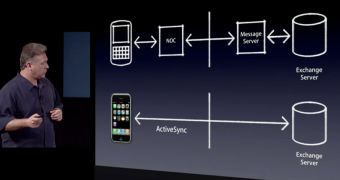During Apple's March 6 event at the Cupertino HQ, the company's senior vice president of product marketing, Phil Schiller, took on the Blackberry outlining an imperfect communication method used by many organizations. Seemingly, Apple's new ActiveSync-based method, which will enable a direct connection with Exchange servers in the enterprise, is not as secure as they want us to believe, according to an American Technology Research report.
"Every e-mail message sent to or from a RIM device, goes through a NOC up in Canada. Now, that provides a single point of failure, but it also provides a very interesting security situation. Where someone working up at that NOC could potentially be having a look at your e-mail. Nobody seems to be focused on that. We certainly are," Jobs proudly stated at the iPhone Software Roadmap event.
Talking in RIM's favor, an American Technology Research report issued via AppleInsider points out to the BlackBerry Enterprise Server (BES) and the BlackBerry device which both "share a unique randomly generated security key based on triple-DES encryption which is considered unbreakable," the researchers explained. "The BES server encrypts all information with this key while behind the corporate firewall, before passing through the NOC" (network operations center).
According to the researchers, "the only decryption key in existence resides on the handheld device, which gives BlackBerry the highest level of security in the industry."
So, even though messages must check in through a high number of servers, they are encrypted when they are sent, and decrypted when received, giving BlackBerry users maximum security, and also dismissing Jobs' statement that "NOC could potentially be having a look at your e-mail."
More than that, the researchers claim the iPhone will interface directly with the Exchange server, once the service is up and running with the release of the 2.0 iPhone software, with analysts speculating that the ActiveSync implementation may just have a few bugs of its own, as far as security goes. The method may also affect battery life and scalability, they claim.
ActiveSync and Microsoft Exchange support is only one of the requested enterprise iPhone features, part of the 2.0 software update due out this summer (June).

 14 DAY TRIAL //
14 DAY TRIAL //